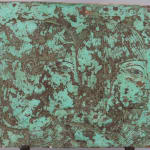New Kingdom Relief with Two Female Figures, 1550 BC - 1077 BC
Stone
21.5 x 33 x 3 cm
8 1/2 x 13 x 1 1/8 in
8 1/2 x 13 x 1 1/8 in
GM.0071
Further images
-
(View a larger image of thumbnail 1
)

-
(View a larger image of thumbnail 2
)

-
(View a larger image of thumbnail 3
)

-
(View a larger image of thumbnail 4
)

-
(View a larger image of thumbnail 5
)

-
(View a larger image of thumbnail 6
)

-
(View a larger image of thumbnail 7
)

-
(View a larger image of thumbnail 8
)

An outstanding Egyptian relief in limestone dating to the New Kingdom (1550 BC - 1077 BC). This relief is most probably the only surviving fragment of a much more complex...
An outstanding Egyptian relief in limestone dating to the New Kingdom (1550 BC - 1077 BC). This relief is most probably the only surviving fragment of a much more complex and large iconographic apparatus that included several full figures and rows of hieroglyphic inscriptions.
Two women are represented in profile, looking towards the right. They both wear two wigs composed of several rows of curls and plaits. The stile of the wigs, in particular the one on the left, resembles the so-called 'Nubian Wigs', which were meant to mimic the short curly hair that Nubian tribespeople wore. These kind of headwear grew in popularity since the middle of the XVIII Dynasty. Some scholars refer to the kind of wigs represented in this relief, composed of several rows of curls and plaits, as 'duplex' style. This implies their existence as a kind of intermediary type between the Nubian and traditional Egyptian styles. The characters wear around their necks some splendid jewellery: a necklace composed by several rows of vertical elements gathered by bands. The ear of the character on the left is left exposed by the wig: it is skilfully rendered with great anatomical accuracy. Cosmetic lines are well realised in relief, and further marked by delicate traits of black paint.
The relief is covered in green lacquer. In Ancient Egypt the colour green was associated with life and vegetation. However, it was also linked with the ideas of death. Green was -so to say- was the colou r of fresh growth, vegetation, new life and resurrection. In fact, Osiris, the Egyptian god of fertility, death and afterlife, was commonly portrayed as having green skin. The presence of green lacquer allows to propose a possible funerary provenance for this relief.
The artwork was executed with great care and skill by the artist, and it's most probably the last surviving fragment from a much more complex set of depictions. The delicateness of the features and the serene expression of the characters showcase the mastership and level of extraordinary artistic accomplishments of Egyptian art during the New Kingdom, one of the golden ages of the Ancient World. This is a sublime work of art, befitting the most important and renowned collections.
Two women are represented in profile, looking towards the right. They both wear two wigs composed of several rows of curls and plaits. The stile of the wigs, in particular the one on the left, resembles the so-called 'Nubian Wigs', which were meant to mimic the short curly hair that Nubian tribespeople wore. These kind of headwear grew in popularity since the middle of the XVIII Dynasty. Some scholars refer to the kind of wigs represented in this relief, composed of several rows of curls and plaits, as 'duplex' style. This implies their existence as a kind of intermediary type between the Nubian and traditional Egyptian styles. The characters wear around their necks some splendid jewellery: a necklace composed by several rows of vertical elements gathered by bands. The ear of the character on the left is left exposed by the wig: it is skilfully rendered with great anatomical accuracy. Cosmetic lines are well realised in relief, and further marked by delicate traits of black paint.
The relief is covered in green lacquer. In Ancient Egypt the colour green was associated with life and vegetation. However, it was also linked with the ideas of death. Green was -so to say- was the colou r of fresh growth, vegetation, new life and resurrection. In fact, Osiris, the Egyptian god of fertility, death and afterlife, was commonly portrayed as having green skin. The presence of green lacquer allows to propose a possible funerary provenance for this relief.
The artwork was executed with great care and skill by the artist, and it's most probably the last surviving fragment from a much more complex set of depictions. The delicateness of the features and the serene expression of the characters showcase the mastership and level of extraordinary artistic accomplishments of Egyptian art during the New Kingdom, one of the golden ages of the Ancient World. This is a sublime work of art, befitting the most important and renowned collections.







